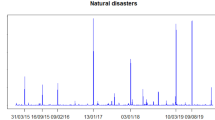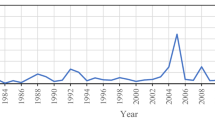Abstract
This paper proposes a statistical model for insurance claims arising from climatic events, such as tornadoes in the USA, that exhibit a large variability both in frequency and intensity. To represent this variability and seasonality, the claims process modelled by a Poisson process of intensity equal to the product of a periodic function, and a multifractal process is proposed. The size of claims is modelled in a similar way, with gamma random variables. This method is shown to enable simulation of the peak times of damage. A two-dimensional multifractal model is also investigated. The work concludes with an analysis of the impact of the model on the yield of weather bonds linked to damage caused by tornadoes.







Similar content being viewed by others
References
Barrieu, P., & Scaillet, O. (2010). “A primer on weather derivatives.” In: Filar, Jerzy A. and Haurie, Alain, (eds.), Uncertainty and environmental decision making: A handbook of research and best practice. International series in operations research & management science (138) (pp. 155-176). Springer US, doi: 10.1007/978-1-4419-1129-2_5.
Schmock, U. (1999). “Estimating the value of the Wincat coupons of the Winthertur insurance convertible bond.” A study of the model risk. ASTIN Bulletin, 29(1), 101–163.
Barrieu, P., & Dischel, R. (2002).“Financial weather contracts and their application in risk management.” Chapter in Climatic Risk and the Weather Market, Risk Book, Risk Waters Group.
Lopez Cabrera, B. (2010). “Weather Risk Management: CAT bonds and weather derivatives.” PhD Dissertation, Humboldt Universitaet, Berlin. http://edoc.hu-berlin.de/dissertationen/lopez-cabrera-brenda-2010-04-27/PDF/lopez-cabrera.pdf.
Vaugirard, V. (2003). Valuing catastrophe bonds by Monte Carlo simulations. Applied Mathematical Finance, 10, 75–90.
Lee, J. P., & Yub, M. T. (2007). Valuation of catastrophe reinsurance with catastrophe bonds. Insurance: Mathematics and Economics, 41(2), 264–278.
Alaton, P., Djehiche, B., & Stillberger, D. (2002). On modelling and pricing weather derivatives. Applied Mathematical Finance, 9, 1–20.
Campbell, S., & Diebold, F. (2005). Weather forecasting for weather derivatives. Journal of American Statistical Association, 100(469), 6–16.
Dornier, F., & Queruel, M. (2000). "Caution to the wind." Risk Magazine, EPRM, July, pp. 30-32.
Benth, F. E., & Benth, J. S. (2007). The volatility of temperature and pricing of weather derivatives. Quantitative Finance, 7(5), 553–561.
Benth, F. E., & Benth, J. S. (2009). The volatility of temperature and pricing of weather derivatives. Quantitative Finance, 7(5), 553–561.
Hainaut, D. (2012). “Pricing of an insurance bond, with stochastic seasonal effects.” Bulletin Français d'actuariat. Juillet 2012.
Chiera, B. A., Filar, J. A., Zachary, D. S., & Gordon, A. H. (2010). “Comparative Forecasting and a test of Persistence in the El Nino Southern Oscillation” In: Filar, Jerzy A. and Haurie, Alain, (eds.), Uncertainty and environmental decision making: A handbook of research and best practice. International series in operations research & management science (138) (pp. 255-273) Springer.
Lovejoy, S., & Schertzer, D. (2007). Scale, scaling and multifractals in geophysics: Twenty years on. Nonlinear dynamics. In: A. A. Tsonis, J. Elsner (Ed.), Geosciences (pp. 311-337). Springer.
Sachs, D., Lovejoy, S., & Schertzer, D. (2002). The multifractal scaling of cloud radiances from 1m to 1km. Fractals, 10, 253–265.
Tchiguirinskaia, I., Schertzer, D., Lovejoy, S., & Veysseire, J. M. (2006). Wind extremes and scales: multifractal insights and empirical evidence, In: EUROMECH Colloquium on Wind Energy, edited by P. S. Eds. J. Peinke, Springer-Verlag.
Calvet, L., & Fisher, A. J. (2008). "Multifractal volatility. Theory, forecasting and pricing". Academic Press. Elsevier.
Resnick, S., & Samorodnitsky, G. (2003). Limits of on/off hierarchical product models for data transmission. The Annals of Applied Probability, 13(4), 1355–1398.
Mu, M., & Zheng, Q. (2005). Zigzag oscillation in variational data assimilation with physical "on-off" processes. Monthly Weather Review, 133.
Brody, D. C., Syroka, J., & Zervos, M. (2002). “Dynamical pricing of weather derivatives”. Quantitative Finance 2, p. 189-198.
Mandlebrot, B. (1982). "The fractal geometry of nature". Freeman.
Mandelbrot, B. (1997). Fractals and scaling in finance: Discontinuity, concentration, risk. Berlin: Springer Verlag.
Mandlebrot, B. (2001). Scaling in financial prices: Multifractals and the star equation. Quantitative Finance, 1, p124–p130.
Major, J. A., & Lantsman, Y. (2001). "Actuarial applications of multifractal modeling part 1: Introduction and spatial applications." Non-refereed Paper of the Casualty Actuarial Society Forum.
Jung, R. C., & Tremayne, A. R. (2011). Useful models for time series of counts or simplywrong ones? AStA Advances in Statistical Analysis, 95(1), 59–91.
Bremaud, P. (1981). Point processes and queues martingales dynamics. New York: Springer Verlag.
Lecki, T. R., & Rutkowski, M. (2004). "Credit risk: Modeling, valuation and hedging". Springer Finance.
Hamilton, J. D. (1989). A new approach to the economic analysis of nonstationary time series and the business cycle. Econometrica, 57(2), 357–384.
Kalman, R. E. (1960). A new approach to linear filtering and prediction problems. Journal of Basic Engineering, 82(1), 35–45.
Calvet, L., & Fisher, A. J. (2001). Forecasting multifractal volatility. Journal of Econometrics, 105, 27–58.
Author information
Authors and Affiliations
Corresponding author
Appendix A.
Appendix A.
Proving the fractal nature of the number and cost of claims can be done by a visual analysis of autocovariance in levels. For any integrated process Z (number or cost of claims), the autocovariance in levels is defined as:
and which quantifies the dependence of the size of increments
such that statistical moments exist. Calvet and Fisher [30] show that multifractal processes have hyperbolically declining autocovariances in levels when t/Δt → ∞. In Fig. 8, these autocovariances (q = 2) are plotted for N t − λ(t) and for C t − τ(t). Autocovariances are well hyperbolically decreasing. The same trends are observed if q = 3.
Rights and permissions
About this article
Cite this article
Hainaut, D., Boucher, JP. Frequency and Severity Modelling Using Multifractal Processes: An Application to Tornado Occurrence in the USA and CAT Bonds. Environ Model Assess 19, 207–220 (2014). https://doi.org/10.1007/s10666-013-9388-9
Received:
Accepted:
Published:
Issue Date:
DOI: https://doi.org/10.1007/s10666-013-9388-9





